
* Although the Soviet Union more or less abandoned development of piloted supersonic bombers in the early 1960s in favor of long-range missiles, by the late 1960s work on such aircraft had been revived. The Sukhoi organization developed a flying prototype of the "T-4", which had some resemblance to a scaled-down version of the US XB-70 experimental bomber. The T-4 did not enter production, but a larger supersonic bomber, the Tupolev "Tu-160", did enter service, and remains in operation in the 21st century. This document provides a history and description of the T-4 and Tu-160.
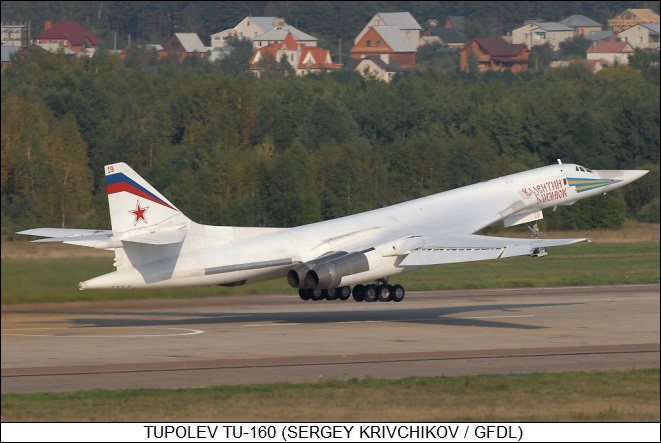
* During the 1950s, Soviet Premier Nikita Khrushchev displayed a strong bias towards long-range missiles as the USSR's primary strategic nuclear delivery system, with a number of promising manned bomber concepts killed off as a result. In the late 1950s and early 1960s, however, American supersonic bomber efforts -- including the Convair B-58 Hustler and particularly the North American XB-70 -- persuaded the Kremlin that the Soviets should respond with a supersonic bomber of their own.
As specified, the new bomber was to have a top speed of Mach 3 and a cruise speed of Mach 2.8, with a typical Soviet capability of operating off unimproved airstrips. It was not actually planned as a rival to the American's intercontinental XB-70, the Soviet machine being intended as a medium-range aircraft to attack tactical ground targets and Western naval task forces. It was to carry air-to-surface missiles (ASM) to provide a stand-off strike capability. The aircraft was also to be used for the strategic reconnaissance mission.
The Tupolev, Yakovlev, and Sukhoi experimental design bureaus (OKB in the Russian acronym) all submitted proposals. The Yakovlev concept didn't meet requirements and was quickly discarded, with a protracted bureaucratic tug-of-war between the Tupolev and Sukhoi OKBs following. Somewhat surprisingly, since Tupolev had become established as the USSR's main builder of bombers, Sukhoi won the competition, with the OKB's engineers moving on to an advanced design study of the "Izdeliye 100 (Product 100 / I-100)", or "T-4" as it was known. Along with bomber and reconnaissance variants, the Sukhoi OKB also considered heavy fighter and supersonic transport (SST) derivatives of the basic aircraft design. The refined bomber design was submitted to the state apparatus in April 1963, leading to approval for full development of the T-4, with initial flight then scheduled for 1968.
The configuration of the aircraft evolved considerably through its design history, but the finalized design was a dartlike machine, with a slender fuselage, cranked "double delta" wing, canard foreplanes, and four afterburning turbojet engines in a unitary "wedge" nacelle under the centerline between the wings. A full-scale mockup was completed in late 1966, featuring provisions for both the stand-off-missile carrier and reconnaissance configurations -- the airframe being much the same, just with different equipment fits. Work then went forward on the construction of two prototypes, including a flight prototype and a ground-test airframe.
* Development of the T-4 pushed the state of the art of Soviet aircraft design and the flight prototype, numbered "101", was not actually rolled out until late 1971. The aircraft was very rakish, with its double-delta wing featuring a leading-edge sweep of 74 degrees 44 minutes inboard and 60 degrees 7 minutes outboard. There were three-section "elevon" control surfaces at the back of each wing, and a two-section rudder; the canards appear to have been all-moving, though sources are not clear on that detail. Various wing configurations for the T-4 had been flight-tested on a Sukhoi Su-9 interceptor in 1966 to validate the wing configuration. Similarly, the T-4's canard nose fins had been flight-tested on an Su-7U trainer in 1968. Still more flying testbeds trialed avionics and other systems.
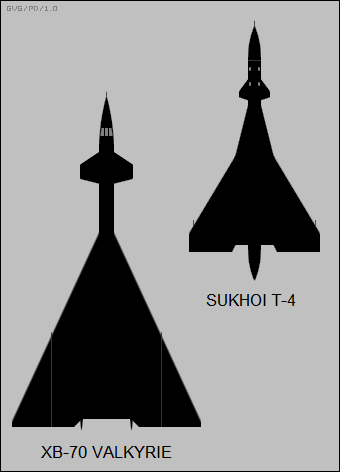
The T-4 was powered by four Kolesov RD36-41 turbojets, providing a maximum thrust of 156.9 kN (16,000 kgp / 35,273 lbf) each in afterburner. There were only two inlets for the four engines. Landing gear consisted of two-wheel nose gear, retracting backwards into the front of the engine nacelle; and eight-wheel main gear, in a 2x4 configuration, on the rearward corners of the nacelle that apparently retracted up and forward. A brake chute assembly, with four cruciform parachutes, was stowed in the extreme tail and was deployed to reduce landing roll.
The T-4 was a "dynamically unstable" aircraft, and so an advanced analogue-electronic "fly by wire (FBW)" flight control system was developed to keep it flying right; an automated throttle system or "auto-throttle" was also developed since engine management on landing could be tricky. In full flight the T-4 was effectively flown on instruments, with the only effective cockpit glazing being two small windows on each side. For take-offs and landings, the nose drooped down to reveal a three-panel windshield. There were two crew, including pilot and navigator / weapons system operator. They sat in tandem and got in or out of the machine through individual hatches on top of the cockpit, positioned off-center to the left, with the hatches hinging upward from the rear. Apparently the crew sat on upward-firing ejection seats, but sources are also not clear on this matter.
___________________________________________________________________
SUKHOI T-4:
___________________________________________________________________
wingspan:
22 meters (72 feet 2 inches)
wing area:
295.7 sq_meters (3,180 sq_feet)
length:
44.5 meters (146 feet)
height:
11.19 meters (36 feet 8 inches)
empty weight:
54,800 kilograms (120,810 pounds)
normal loaded weight:
128,000 kilograms (282,185 pounds)
MTO weight:
136,000 kilograms (299,825 pounds)
max speed at altitude:
3,200 KPH (1,985 MPH / 1,730 KT)
service ceiling:
20,000 meters (24,000 feet)
range (no tanks):
6,000 kilometers (3,725 MI / 3,245 NMI)
___________________________________________________________________
Baseline offensive armament was to be two Raduga Kh-45 long-range stand-off missiles, being developed concurrently, for anti-ship or land attack, armed with conventional or nuclear warheads. The T-4 was to be fitted with appropriate navigation / fire-control radar and datalinks for targeting systems, but details are again unclear. There was no defensive armament, the T-4 relying on speed and a sophisticated electronic countermeasures (ECM) suite for protection. External fuel tanks could be carried to extend range. Reconnaissance gear was to include film cameras, infrared imagers, and a side-looking airborne radar (SLAR), with the reconnaissance gear at least partly carried externally. Maximum payload was 19 tonnes (20.9 tons).
Work on the T-4 required advances in production of parts made of titanium and heat-resistant steel, with an automated production facility set up to streamline the task. Such a complicated aircraft was seen as a handful for two crew, so automated systems were also developed to reduce crew workload. A new "high-flashpoint" fuel was developed to permit safe fuel storage at high airframe temperatures. The T-4 was nicknamed the "Sotka", meaning "Hundred" and standing for the I-100 product code. Thanks to the product code, the aircraft was occasionally referred to in the West as the "Su-100", but the Soviets never referred to it in such a way.
* The Sotka performed its initial flight on 22 August 1972 from the Zhukovskiy test center near Moscow, with well-known test pilot Vladimir Ilyushin at the controls and Nikolay Alfyorov in the navigator's seat. The flight had been delayed because of forest fires in the area that filled the sky with smoke. The T-4 performed nine more test flights, reaching Mach 1.28 on the second to last. There were various bugs that needed fixing, but otherwise the aircraft clearly seemed to meet performance spec; handling was very good, all the way from taxiing to high-speed flight. Field of view for landings with the nose drooped was judged excellent.
A second prototype, tailcode "102", had been completed and more prototypes were in construction, with an order for 250 production machines in the wings, when the project was canceled. The Tupolev OKB had been able to sell the Kremlin on their own solution for the theater bomber requirement, the "Tu-22M". The name was misleading, identifying it as a follow-on to the unsatisfactory Tu-22 "Blinder" when it was effectively a completely new design that nobody could mistake for the Tu-22. It went into production, to be given the NATO reporting name of "Backfire", and the T-4 was history.
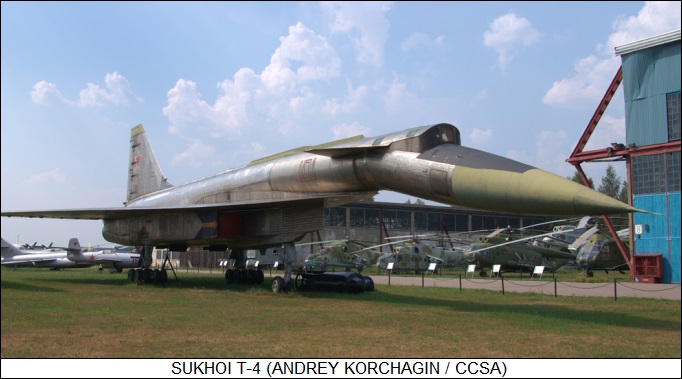
The 101 flight prototype of the T-4 only took to the air ten times, with the last flight on 22 January 1974. It finally ended up in the air museum at Monino, where it survives to this day. The 102 flight prototype never left the ground and was eventually scrapped. The Sukhoi OKB came up with paper designs for refined follow-ons, with features such as variable-geometry ("swing") wings and stealth, but as discussed later, they didn't happen.
BACK_TO_TOP* Although the North American XB-70 bomber project had been canceled in the early 1960s, the USA continued to tinker with various advanced manned bomber concepts through the decade, which would lead to the development of the Rockwell B-1 from the 1970s. The Soviets were perfectly aware of the American bomber studies, and in November 1967 the authorities issued a requirement for a new long-range strategic bomber of their own, envisioned as a high-altitude, long-range, Mach 3 machine primarily armed with stand-off weapons.
As mentioned above, the Sukhoi OKB proposed a derivative of the T-4, the "T-4M", featuring swing wings. Analysis of this design eventually showed that it left something to be desired, and so Sukhoi engineers came up with a new proposal, designated the "T-4MS", though it had little or nothing in common with the original T-4. The T-4MS was an odd-looking machine, something like a triangle with two corners chopped off and a swing wing inserted in the cut on each side.
The design OKB under the direction of Vladimir Myasishchev -- which had built the subsonic M-4 "Bison" and the one-off supersonic M-50 "Bounder" heavy jet bombers before being disbanded in 1960, to be resurrected in 1966 -- worked on their own concepts in parallel, under the designation "M-20". The initial concept was a swing-wing aircraft with a strong resemblance to a scaled-up version of the US General Dynamics F-111 "Aardvark". This led to a canard aircraft with a "cranked arrow" wing; then concepts for canards with swing wings; and finally a concept for a swing-wing aircraft with a conventional rear tail assembly that had a resemblance to the US B-1.
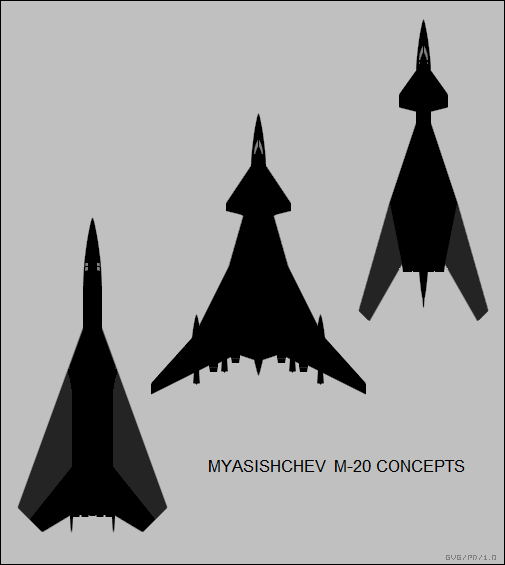
In 1970, the Tupolev OKB entered the competition, proposing a series of double-delta flying wing machines under the designation of "160M". The final selection turned out to be complicated; there was an initial round of consideration in 1972 that came out in favor of the Sukhoi T-4MS, but the conclusion was that the initial requirements simply could not be met by any of the designs. The top speed requirement was dropped to Mach 2+ -- though there was no flexibility on the range requirement -- with the various OKBs then submitting revised proposals. The authorities selected from them the Myasishchev "M-18", which was a simplified and slightly modified version of the final M-20 design, with swing wings and a conventional tail assembly. Ironically, since the Myasishchev OKB lacked the resources to develop such a complicated aircraft, full development was passed on to the Tupolev OKB.
* Turning what amounted to a general concept of an aircraft into something that flew was of course not trivial, and a full-scale mockup of the Tupolev "Tu-160", as it had been designated, wasn't available until 1977. The mock-up was approved and work then began on three prototypes, including two flight prototypes and one static-test airframe.
The initial flight prototype, tailcode "70-01", was assembled at the Zhukovskiy flight test center near Moscow and performed its initial taxi test on 14 November 1981. Initial flight was on 18 December 1981, with Boris Veremey at the controls, accompanied by copilot Sergey Agapov, plus navigators Mikhail Kozel and Anatoliy Yeremenko. Three months later, Veremey took 70-01 to its top speed of 2,200 KPH (1,365 MPH). It was photographed by a foreign airline passenger coming into Moscow, with the prototype sitting next to two Tupolev Tu-144 SSTs. The passenger published the photo. Since the name of the Zhukovskiy test center was not known outside the USSR at the time, it was known as "Ramenskoye" after a nearby town, and the mystery aircraft was accordingly labeled "Ram-P". It was later given the NATO reporting name of "Blackjack".
The initial flight prototype was not close to operational specification; the second flight prototype, "70-03", was essentially a preproduction machine, very near service spec, and unsurprisingly it took a lot more work to bring the design to that state. As a result, the second flight prototype didn't take to the air until 6 October 1984. Production had already been authorized, to take place at a state factory in Kazan, with the first production machine flying on 10 October 1984 -- less than a week after the initial flight of 70-03.
However, bringing the Tu-160 into operational service was, once again, not trivial, and the VVS (Voyenno Vozdushniye Sily / Red Air Force) didn't declare the type operational until April 1987. The first squadron was complete by the end of 1988; two squadrons had been filled out by the time the Soviet Union collapsed in 1991. Incidentally, at last notice the initial flight prototype remains at Zhukovskiy in a state of disrepair.
BACK_TO_TOP* As introduced, the Tupolev Tu-160 had a general resemblance to the US B-1, though the Tu-160 was a substantially bigger aircraft and had little similarity in detail; nobody at all familiar with aircraft would confuse the two. As mentioned, the Tu-160 had a low-mounted swing wing, with "wing-body blending" between the fuselage and the inner fixed wing glove sections, and a conventional swept tail assembly. It appears to have been made mostly of aircraft aluminum alloy, with some titanium and composite assemblies.
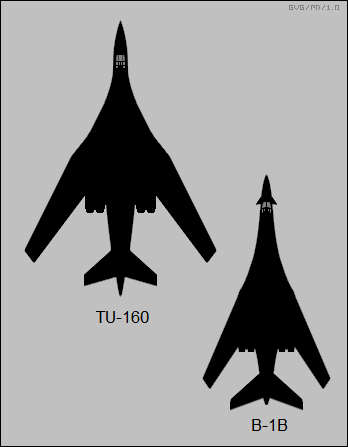
The Tu-160 was powered by four Kuznetsov NK-32 afterburning low-bypass-turbofan jets with a maximum dry thrust of 137.3 kN (14,000 kgp / 30,872 lbf) and a maximum afterburning thrust of 245.2 kN (25,000 kgp / 55,140 lbf) each. There was an engine pod under each wing glove, with twin engines in each pod; the inlets were variable, using hinged ramps mounted on the centerwall of each split inlet. The engine pods featured large hinged panels to ease service crew access and swapout of engines.
There were 13 fuel tanks in the center wing-body section and swing wings, and there was a pop-up inflight refueling probe in the nose ahead of the cockpit. The Blackjack had tricycle hydraulically-actuated landing gear, with twin-wheel nose gear that retracted backwards, and six-wheel main gear arranged as three rows of duals that retracted back into the fuselage just inboard of the engine pods. A brake chute system, with three cruciform parachutes, reduced landing roll.
There were three wing sweep settings, from 20 degrees when the wings were fully extended for take-off or landing; to 35 degrees for high-speed cruise; and to a fully-swept 65 degrees for Mach 2 dash. The control surface arrangement on the pivoting wing sections was elaborate, with each wing featuring three-section double slotted flaps; a five-section spoiler ahead of the flaps; an aileron outboard; and a four-section leading-edge slat. There was an unusual moveable surface at the rear of the wing near the wing joint, which folded flat when the wings were extended to cover the "gap" between the rear wing glove and swing wing, while being pivoted vertically to act as a "wing fence" of sorts when the wings were fully swept.
The tailplanes were mounted on the tailfin a short distance above the fuselage and were all-moving. They could be pivoted in alternate directions for roll control, the ailerons only being used when the wings were fully extended. There was no rudder as such, the tailfin being all-moving above the tailplane. Incidentally, the Myasishchev M-20 concept that led to the Tu-160 had a tee tail, though the configuration was otherwise similar to the aircraft that actually flew.
___________________________________________________________________
TUPOLEV TU-160:
___________________________________________________________________
wingspan (extended):
55.7 meters (182 feet 9 inches)
wing area (extended):
293.2 sq_meters (3,155 sq_feet)
wingspan (swept):
35.6 meters (116 feet 10 inches)
wing area (swept):
232 meters (2,497 feet 10 inches)
length:
54.1 meters (177 feet 6 inches)
height:
13.1 meters (42 feet 11 inches)
empty weight:
117,000 kilograms (257,940 pounds)
MTO weight:
275,000 kilograms (606,260 pounds)
max speed at altitude:
2,200 KPH (1,365 MPH / 1,190 KT)
service ceiling:
15,600 meters (51,180 feet)
range:
12,300 kilometers (7,640 MI / 6,640 NMI)
___________________________________________________________________
There were twin tandem weapons bays, each 11.28 meters (37 feet) long and 1.92 meters (6 feet 4 inches) wide. Standard armament consisted of 12 Raduga Kh-55 or enhanced-range Kh-55SM (NATO AS-15B Kent) cruise missiles -- similar to the US Tomahawk cruise missile -- with six on a rotary launcher in each weapons bay. The Tu-160 could also carry the "Kh-555", a conventionally-armed conversion of the Kh-55. An alternate warload, apparently not carried much in practice, consisted of 24 Raduga Kh-15 (NATO AS-16 Kickback) solid-fuel stand-off missiles -- similar to the US SRAM missile -- with six each on four rotary launchers, two launchers per weapons bay.
The Raduga Kh-45 stand-off missile envisioned for the T-4 was initially regarded as the primary store of the Tu-160, but the Kh-45 was canceled. A new "Kh-102" cruise missile, something like a bigger, stealthier derivative of the Kh-55, was fielded, with six carried on a bomb bay rotary launcher. In principle, the Tu-160 could also carry up to 40 tonnes (44 tons) of nuclear or conventional free-fall munitions, though at the outset it was not assigned any conventional strike role.
Avionics included:
Of course, the Tu-160 had standard avionics such as radios and identification friend or foe (IFF) transponder. While Russian sources say little about defensive systems, the Blackjack carried passive warning systems, active jamming systems, and chaff-flare dispensers. The aircraft used a distributed digital control system built around a network of a hundred processors, and a quadruple-redundant FBW flight control system. There was a backup mechanical flight control system, but given that the Tu-160 was dynamically unstable, it is unclear just how useful it could be in practice.
There were four crew sitting in the pressurized cockpit in a 2x2 arrangement, including pilot (front left seat), co-pilot (front right seat), navigator / offensive systems operator (back left seat), and navigator / defensive countermeasures systems operator (back right seat). All crew sat on Zvezda K-36LM "zero zero (zero altitude zero speed)" ejection seats, which fired upward through doors on the roof of the cockpit. The ejection seats were eventually modified to pneumatically "pulse" to provide a massage, reducing crew weariness on long missions. The pilot and copilot had fighter-like sticks instead of yoke controls; cockpit layout was traditional, based mostly on dial indicators and displays, backwards by Western standards. A small galley and toilet were provided for crew comfort, unusual luxuries by the standards of Soviet-Russian combat aircraft. The crew got into and out of the aircraft through a door in the nose gear wheel well.
The normal color scheme for the Tu-160 was overall white, which led aircrews to nickname it the "White Swan". Individual aircraft were generally named after Russian heroes.
BACK_TO_TOP* By the time of the collapse of the Soviet Union in 1991, 32 operational Tu-160s had been built, with four more in assembly -- all of which were eventually completed, one each in 1999, 2007, 2017, and 2018. With the breakup of the old Soviet empire, 19 of these aircraft ended up in the hands of Ukraine; the Russians inked a deal with the Ukrainians in 1999 to obtain eight of these Tu-160s, in exchange for debt forgiveness. The Ukrainians, who had declared themselves a non-nuclear power, scrapped the rest, except for one reserved as a museum display.
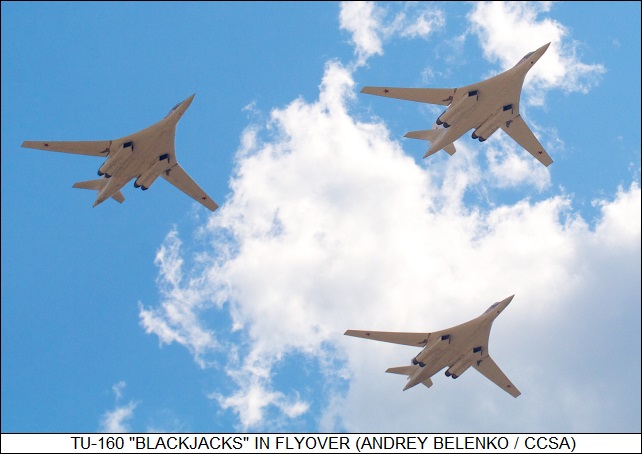
Ironically, the Tu-160 was not formally accepted into full VVS service until the end of 2005, an indication of the chaos in the new Russian state. As of 2015, the VVS had 16 operational Tu-160s, it seems including a number being used in trials, and with two having been lost in crashes; the goal is to bring the fleet up to 30, via rebuilds or new production. The small number of Tu-160s in VVS service have a visibility all out of proportion to their numbers, since in 2007 Russian President Vladimir Putin announced that Russian would resume strategic flights that had been abandoned from 1991. Since that announcement, the Tu-160s have flown across the oceans and occasionally brushed Western airspaces, to be escorted by intercepting fighters.
The strategic flights were strictly political in nature, little more than a symbol that Russia still remained a strategic military power. Tu-160s also conducted missions in support of the Syrian government from 2015, launching cruise missiles to perform strikes on rebel groups.
Only one model of the Tu-160 has been produced, but a number of others were considered, though ultimately not implemented:
One of the most interesting concepts was the "Tu-160SK", which was to be a carrier for the "Burlak" light space launch vehicle, hauled under the aircraft's centerline. The Burlak was to be able to put about a tonne in low Earth orbit. A Tu-160 dummied up as a Tu-160SK was displayed at the Paris Air Show in 1995, that being the first time a Tu-160 was flown to the West for a close inspection. The Burlak program ended up in limbo.
During the 1980s, the Tupolev OKB conducted studies on a Mach 4 "Tu-260" and a Mach 6 "Tu-360" follow-ons. They had little resemblance to the Tu-160, looking more like some kind of space shuttle; neither project went anywhere, which was just as well. As the speed of an intercontinental-range aircraft increasingly goes above Mach 3, it becomes more and more sensible to consider a suborbital vehicle that doesn't have to worry about the atmosphere getting in the way. There was more realistic work on a flying-wing bomber, the "B-90", somewhat comparable to the US B-2 Stealth Bomber, but the B-90 also came to nothing.
* Although none of the follow-on Tu-160 variants actually happened, they did contribute ideas and technology for improvements to the existing Tu-160 fleet. Blackjacks have been updated to "Tu-160M1" configuration, featuring:
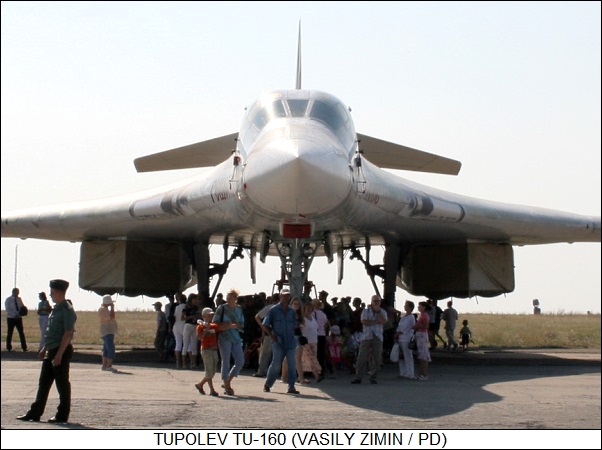
Initial flight of an upgraded aircraft was in late 2014, with the last redelivered in 2020. A second-stage "Tu-160M" -- originally "Tu-160M2" -- upgrade is adding a full glass cockpit and a modernized NVI-70 (Novella-70) radar, plus other updated avionics systems. Much the same updates are being provided to the upgraded Tu-22M3M "Backfire" bomber. New production Tu-160s are also in the works, with the first flying in 2022.
In 2013, the Russian government announced plans to obtain a replacement for the Tu-160; apparently the replacement was to be a new Tupolev flying-wing design, comparable to the US B-2 Stealth bomber. The project was designated the "Prospective Aviation Complex for Long-Range Aviation", or "PAK-DA" in its Russian acronym. An ambitious schedule was announced, but it's unlikely to happen. The Russian invasion of Ukraine in 2022 proved a disastrous blunder, giving the prospect of the collapse of the Russian state. Incidentally, the Tu-160 had little participation in the conflict, being reserved for the strategic mission.
BACK_TO_TOP* Sources include:
Some comments were also obtained from the Wikipedia article on the Tu-160.
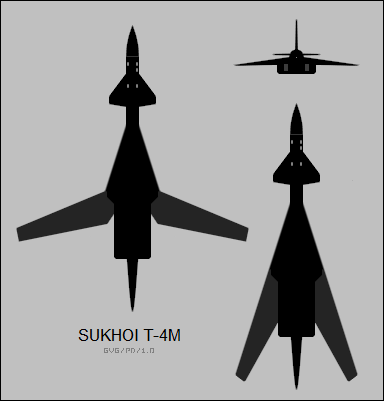
* Revision history:
v1.0.0 / 01 dec 09 v1.0.1 / 01 nov 11 / Review & polish. v1.0.3 / 01 oct 13 / PAK-DA. v1.0.4 / 01 mar 15 / Review & polish. v1.0.5 / 01 feb 17 / Review & polish. v1.0.6 / 01 jan 19 / Review & polish. v1.0.7 / 01 nov 20 / Review & polish. v1.1.0 / 01 aug 22 / Review & polish. v1.1.1 / 01 aug 22 / Review & polish. (+)BACK_TO_TOP
